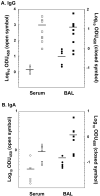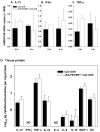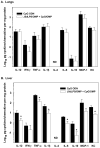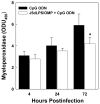Detoxified endotoxin vaccine (J5dLPS/OMP) protects mice against lethal respiratory challenge with Francisella tularensis SchuS4
- PMID: 20170768
- PMCID: PMC2847053
- DOI: 10.1016/j.vaccine.2010.01.067
Detoxified endotoxin vaccine (J5dLPS/OMP) protects mice against lethal respiratory challenge with Francisella tularensis SchuS4
Abstract
Francisella tularensis is a category A select agent. J5dLPS/OMP is a novel vaccine construct consisting of detoxified, O-polysaccharide side chain-deficient, lipopolysaccharide non-covalently complexed with the outer membrane protein of N. meningitidis group B. Immunization elicits high-titer polyclonal antibodies specific for the highly-conserved epitopes expressed within the glycolipid core that constitutes gram-negative bacteria (e.g., F. tularensis). Mice immunized intranasally with J5dLPS/OMP exhibited protective immunity to intratracheal challenge with the live vaccine strain, as well as the highly-virulent SchuS4 strain, of F. tularensis. The efficacy of J5dLPS/OMP vaccine suggests its potential utility in immunizing the general population against several different gram-negative select agents concurrently.
(c) 2010 Elsevier Ltd. All rights reserved.
Figures







References
-
- Dennis DT, Inglesby TV, Henderson DA, Bartlett JG, Ascher MS, Eitzen E, et al. Tularemia as a biological weapon: medical and public health management. JAMA. 2001;285(21):2763–73. - PubMed
-
- Johansson A, Ibrahim A, Goransson I, Eriksson U, Gurycova D, Clarridge JE, III, et al. Evaluation of PCR-based methods for discrimination of Francisella species and subspecies and development of a specific PCR that distinguishes the two major subspecies of Francisella tularensis. J.Clin.Microbiol. 2000;38(11):4180–5. - PMC - PubMed
-
- Saslaw S, Eigelsbach HT, Prior JA, Wilson HE, Carhart S. Tularemia vaccine study, II: respiratory challenge. Arch.Int.Med. 1961;107:134–46. - PubMed
-
- Oyston PC, Sjostedt A, Titball RW. Tularaemia: bioterrorism defence renews interest in Francisella tularensis. Nat.Rev.Microbiol. 2004;2(12):967–78. - PubMed
-
- Eigelsbach HT, DOWNS CM. Prophylactic effectiveness of live and killed tularemia vaccines. I. Production of vaccine and evaluation in the white mouse and guinea pig. J.Immunol. 1961;87:415–25. - PubMed
Publication types
MeSH terms
Substances
Grants and funding
LinkOut - more resources
Full Text Sources
Other Literature Sources

